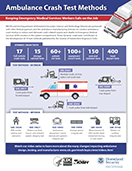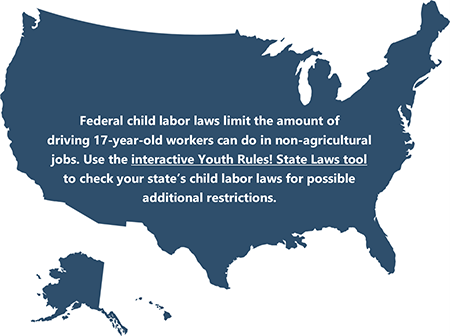Behind the Wheel at Work

Behind the Wheel at Work is a quarterly eNewsletter bringing you the latest news from the NIOSH Center for Motor Vehicle Safety.
Volume 2 Number 3 September 2017
Keeping young drivers safe
Gaining experience. Young drivers ages 16-24 are just beginning to gain experience behind the wheel. Employers and parents can read this month’s newsletter to learn how to keep young drivers safe. Access previous issues of our newsletter.
New webpages/fact sheet: Older drivers and young drivers at work

By year 2020, what percentage of workers will be 55 years or older? How is on-the-job driving by teens limited by age, time, and task? How can you prevent crashes among older drivers and young drivers at work?
Find the answers to these questions – and more! – on our two new webpages, Older Drivers at Work and Young Drivers at Work. Plus, download our new fact sheet, Young Drivers in the Workplace, to promote safe workplace driving.

What is the biggest challenge employers in your industry face with managing young employee drivers on the road?
“The biggest challenge in the [oil and gas extraction] industry regarding young employee drivers is: Impressing upon them that driving is a critical part of their job and not simply something they do every day to get to a job site. Young or new employees try hard to make a good impression on their supervisors so they work hard and often end up rushing things. Many have inadequate safe driving skills or an inappropriate attitude about work-related driving… It’s our job to build a culture of driving safety into their work routine to ensure they get home safely every day.”
Colonel Mark Trostel
Driving Safety Advisor, Encana Oil and Gas
“As a safety professional in the [oil and gas extraction] industry for 25+ years, I have learned that our employees are more at risk driving to and from work, than they are working on a drilling rig. Driving while fatigued, driving while distracted or driving under the influence are the most common causes of such off-duty deaths… The ratio of off-duty motor vehicle deaths involving employees, their spouses and their children is 10X greater than our workplace fatalities.
As a parent my greatest fear for the safety of our three sons is a motor vehicle fatality. Therefore, it is important that we reinforce safe driving behaviors by sharing our driving experiences, our mishaps, and personal stories that touch the hearts of the people we love the most.”
Warren Hubler
VP Health, Safety, & Environment, Helmerich & Payne
What, if any, concerns do you have about driving as part of your job?
“My employer talked about driver safety and what I needed to know before I started driving the work vehicle for the company. When I started my job, a fellow coworker accompanied me to… see how well I was able to drive the work vehicle. I was nervous at first but found it helpful knowing the routes and expectations of my boss.”
Jack Danni
Young driver
How do you instill safe-driving habits in your young driver?
“When my children were old enough to ride in a car without a car seat, I always told them to buckle up whether they were in the front or back seat… Also buckling myself up in the vehicle and being a visual example. Now that they are old enough to drive I see they automatically buckle-up. As for them driving a car, I started when they got their learner’s permit and had them drive everywhere. Both in town and on the highway. Teaching them the rules of the road and all the proper driving techniques.”
J.D. Danni
Oil and Gas Specialist, OSHA Region VIII
“My major driving concern for my teenage daughter was distracted driving. Texting for sure. But distracted driving is more than that. It is reading texts on your smart phone. It is talking on the phone (even if you have Bluetooth). It is trying to find the best radio station, or your favorite play list. It is having too many teenagers in the car. We would remind our daughter about the hazards of distracted driving and, when driving, have her promise to turn off her smart phone, put the cell phone in her backpack, and place the backpack in the trunk.”
Tom Hales
Medical Officer, NIOSH
Join us for a #TeenDriver Twitter chat on Oct 18

Fact: young drivers have the highest crash rate, based on miles driven, in the general population. Learn how parents/guardians and employers play an important role in keeping young drivers safe on the road. As part of National Teen Driver Safety Week (October 15-21, 2017), our NIOSH Center for Motor Vehicle Safety and the National Highway Traffic Safety Administration (NHTSA) will co-host a #TeenDriver Twitter chat on October 18 from 3-4 p.m. ET. Follow @NIOSH_MVSafety and @NHTSAgov for more information. As we share questions and answers about teen driver safety, you can join the discussion with comments and questions of your own using #TeenDriver!
Use Z15.1 standard to guide or audit your program

The ANSI/ASSE Z15.1 – 2017 standard, Safe Practices for Motor Vehicle Operations, has been revised and re-approved by the American National Standards Institute (ANSI).
What is Z15.1? It’s a voluntary consensus standard developed and voted on by a committee made up of more than 40 organizations from private, public, and non-governmental sectors.
Who develops the standard? The American Society of Safety Engineers (ASSE) coordinates the work of the Z15.1 committee. CMVS Director Dr. Stephanie Pratt has been a member of the committee since it was formed.
How can employers use Z15.1? Any organization can use the standard to manage motor vehicles it operates, regardless of the number or type of vehicles. It can be the foundation for developing a new motor vehicle safety program, or it can serve as a tool for auditing an existing program.
What’s new in 2017? The 2017 revision to Z15.1 updates and expands topics including seat belt use, fatigue and journey management, and advanced safety features in vehicles. Get more info about Z15.1
CMVS Director quoted in Bloomberg BNA
A recent article in Bloomberg BNA’s Occupational Safety & Health Reporter examines the rising toll of on-the-job highway fatalities. Key members of the ANSI/ASSE Z15 Accredited Standards Committee, including CMVS Director Dr. Stephanie Pratt, are among those quoted in the story. Read the full article.
New infographic: Ambulance crash test methods

NIOSH and the Department of Homeland Security partnered with other federal agencies and ambulance manufacturers to crash-test ambulances, with the goal of preventing crash-related injuries to Emergency Medical Services (EMS) workers in the patient compartment. These dynamic crash tests contributed to the development of 10 test methods published by the Society of Automotive Engineers (SAE).
Download our Ambulance Crash Test Methods infographic to learn how we’re keeping EMS workers safe on the job!
Please send your comments and suggestions to us at kur4@cdc.gov.
Subscribe to Behind the Wheel at Work
Enter your email address to receive research updates, links to motor vehicle safety resources, practical tips on workplace driving, and news about upcoming events.
- Page last reviewed: September 21, 2017
- Page last updated: September 21, 2017
- Content source:
- National Institute for Occupational Safety and Health Division of Safety Research


 ShareCompartir
ShareCompartir


